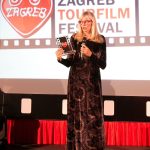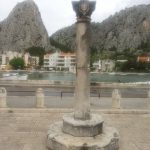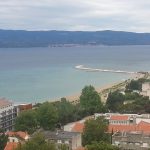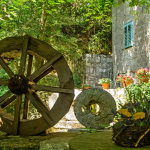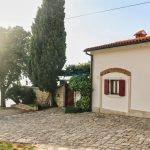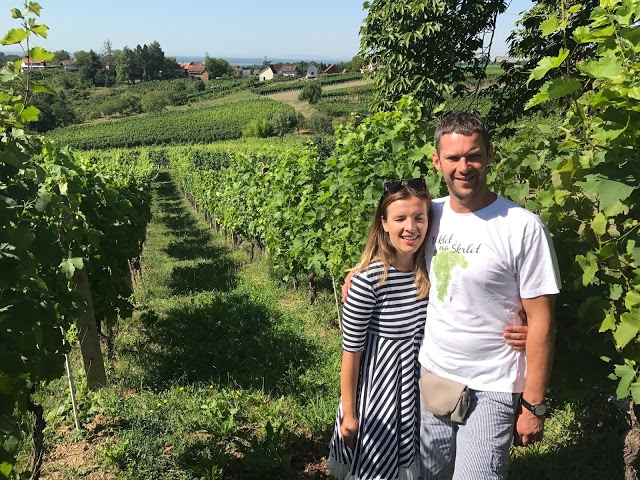
I had a safe job, sleeping above the store, all I had to do was descend to work, “rain or snow, and you don’t need to go outside!” But I decided to try my hand at winemaking, says Tomislav Voštinić-Klasnić
When I spoke to legendary Moslavina winemaker Marko Miklaužić for the first time five years ago, he spoke loudly even then of Škrlet as the in variety, unlike the most popular continental variety Graševina which he called “the setting variety.” I recall our next meeting when he felt he had overstated himself, so much that he called his friend Vlado Krauthaker and apologised to him for such heavy words for a variety which made Slavonia famous.
His son-in-law seems to have taken it literally as, during his recent visit to the Voštinić-Klasnić winery in Graberje Ivanićko near Ivanić Grad, Tomislav Voštinić did not hesitate to emphasise that Marko’s words are coming true in Moslavina. How else can one explain the clearing of both Graševina and Chardonnay from Moslavina vineyards and the planting of Škrlet in their place?
“True, I have already cleared Chardonnay, and just beginning to do so with Graševina, as I am definitely turning toward Škrlet! No matter how much we produce, it all sells! Not just ours, but with other winemakers. All Škrlet producers sell it all! Why would they then drift with Graševina and Chardonnay or any other variety, without degrading any of those varieties? If Škrlet is indigenous here, why not cultivate it, this is where it combined best with the soil and climate. That potential needs to be used. I have around 5-6 hectares of vineyards and to wander around with such small production and have 10 labels of various varieties, would be too much. We made a narrow choice for Škrlet and this path makes me incredibly happy. Marko’s favourite saying is that Škrlet is a “historical artefact,” something not shaped and up to us to shape it. As the first! It is God’s gift,” claims Tomislav, who came to the forefront in a line of Moslavina winemakers by his approach with Škrlet, in many ways different form his colleagues and friends.
Tomislav did marry Marko’s favourite Dunja, after whom her father names his coupage of Muscat varieties, admitting he can learn plenty from his father-in-law, especially in vineyard preparation, but “our ways of thinking and wine perception – are completely different!”
“I did not follow suit and spray milk on the vines, but I had various other attempts. At a Chardonnay position, which we later cleared, I barely picked 100 kilogrammes per 1.000 vines, it all failed in my attempt at ecological production with nettle and other organic means. Then I realised the story with biodynamics and organic production does not work in the wine region! In Požega I enrolled in winemaking, wine and fruit growing studies and stopped in my second year, came upon biodynamics, began reading up on it, researching, and my friend and winemaker Ivan Kosovec headed in the same direction. For me it was truly a large change of direction, a completely new way of life, but I repeat – in Moslavina it doesn’t work, it’s one big story and nothing more! I still play around, this year I planted young Škrlet, certified, cloned, searching for a balance, no extreme is good. I attempted for a young plant not to become resistant to certain agents, using such small doses of protection not to oversaturate the plant so it would not fail when I used unconventional agents. I play around, but these are processes that last for years before first results come in.”
Tomislav likes to boast he was the first, or among the first, to make a sparkling and orange wine from Škrlet, and he refers to Škrlet Unikat as the first predicate edition of the variety, opening a completely new page in the history of Škrlet.
“I am terribly excited ahead of every harvest, as I have so many new ideas I want to try… Škrlet Unikat was created purely by accident, spontaneously, when we harvested the certified plantation with only one grape cluster per vine. When I applied the refractometer and saw 102 oechsl, I could not believe it. A wonderful orange grape! I thought: ‘Hold on, Škrlet as a predicate is not even registered or vinified with the Institute, let’s give it a go!’ Thus I made and registered a predicate harvest of Škrlet to the Institute. This was in 2015. Last year I did the same and dreaded a bit, as Škrlet is not susceptible to botrytis, and the Institute review looks for such botrytis notes. And Škrlet’s virtue is that it has no botrytis! Škrlet’s grape cluster is airy and air constantly runs through it, there are no fungal infections and thus no botrytis. And in late harvest it has an orange grape. I placed sea algae in the soil, bioregulated it, everything was done on a herbal basis… My father-in-law claims Škrlet is not a wine that should be presented like this! Ok, Škrlet indeed needs to be presented primarily as a fresh wine, but why not try to make it also as a predicate. Also, I am not personally a fan of orange wines, but hey, indigenous variety, Škrlet, its own yeasts, orange wine, it’s a trend – let’s try it, let’s take the challenge! So I did, we kept it on grapes for 23 days! And we’ll make it again this year…”
In the development of “orange Škrlet,” Tomislav shows great gratitude to his Slovenian friend, Janez Šekoranja, who usually gives him lots of advice in his wine games. Tomislav calls Janez “old fox,” as “much can be learned from him, and yet he does not want to counsel everyone.”
“For several years he listened carefully to what I say, until he was finally convinced that I adore constantly trying something new. After my stories of orange wine, he decided to come to Graberje Ivanićko. When he saw the wine, he was surprised I sell it. He grabbed his head and said: ‘Close up the wine, hide it, don’t show it to anyone and open it in five years. Then you’ll be able to sell a bottle for 20 euros!’ I listened to him. Now I have around 250 bottles of the wine in half-litre packaging. In fact, I did not expect any successes from that wine, merely a wine to be talked and written about.”
Tomislav does not hide his boyish excitement when he speaks of wine. Additional listening to our conversation shows this excitement prevented Tomislav from completing his sentences, as the thoughts kept surfacing, something new had to be said, an idea explained… And he has continuous fireworks of ideas.
“I am a happy man, I do what I love, I have a healthy family, I feel complete, I need nothing more in life! Everything I desire I make a reality!”
He finally completed the paperwork and in the beginning of summer began a complete renovation of the winery which will include six houses with glass facades facing the vineyards, so guests will feel like they are sleeping in the vineyard itself.
“Such tourism does not exist in continental Croatia. We worked with architects and agencies for two and a half years on developing the idea. We are celebrating the first brick laid on the construction site. The interior capacity of the tasting room will be 45, and the houses will have some 30 beds. I count on all neighbours to join in the story, like smaller producers who copy the project and have accommodation. One of them also has an eco garden… The theme of all our houses will be, you guessed it – Škrlet!”
The label of the ‘regular’ Škrlet is dominated by yellow colour with a semi-sun. Tomislav will heartily explain what a meme is, why yellow is a colour “to which we all return to after we tried it all,” and with such an explanation it is quite logical for Škrlet to be “something new, and in fact – old,” a variety we must return to with a much higher level of knowledge and awareness.
Škrlet Unikat is dressed in another nuance of yellow with a red circle. As Tomislav explained, the dominant yellow colour “leans toward red, as Unikat is riper, fuller, with more alcohol, and the colour in the circle is an association to the vineyard peach.” Unikat was created from grapes from grandfather’s vineyard where the vines are around 60 years old and nothing was treated.
“And when we harvested the grapes, the moon came up and was the same colour as the label! The moon is also on the label due to the strong part it plays during the fermentation of the wine,” explained Tomislav.
The Graševina label is dominated by green. And he will never clear the remaining 2.000 vines.
“These two pine trees, which dominate outside, have been here since the time of my great grandfather and they best illustrate the herbal style of our Moslavina Graševina. Or, as my oenologist would say after tasting the Graševina: “Pine! Pine! This is just like pine!”
The Chardonnay label is dominated by blue, as Tomislav claims “blue is like a meme lived by 80 percent of the population, just like Chardonnay is among the most represented global varieties.”
The Muscat label is dominated by orange and dirt colours, Syrah is marked by purple and the moon… How did Tomislav come to this “colouristic philosophy?”
“It stems from my childhood, from the nature in which I practically grew up in with my grandparents. Everything we commented on is my expression through colour, bottle, labels. Colour labels were created after I described tot eh designer the way I experience my wines. He made some notes, drew and after a month called me to his office and said: “We made you some new labels, but first sit down!” When I asked him to tell me what’s going on, he asked me again to sit down. When I did, he turned on his laptop, I perused what was before me and screamed: ‘You got it all, everything!’”
What is very evident with Tomislav is the immense philanthropy felt especially when he talks of his colleagues. No jealousy or envy at all!
“My vanity is within me against myself. I mostly compete against my own self!”
For the past 14 years he visits the nearby sports gym several times a week and blows off steam by training kick boxing. Before that he vented in table tennis, basketball but also professional football! He played for Ivanić Grad, and his brother Eugen was a Dinamo goalkeeper until he was 18 and then went to play for Gorica in the 2nd League. When they did not make it to the first league, Tomislav talked his brother into leaving football and joining him in the winery.
Tomislav completed his high school in Ruđer Bošković school in Zagreb, in the only class focused on opticians. This was his parents’ wish who wanted to primarily secure for Tomislav a job not overly tedious and which he could do from home.
“Parents figured I would continue their work, but I was still a child, lost, did not know what I want, I just went with it. It was a good job for seven years. I like to say that my work as an optician gave many back their eyesight, just like now, as a winemaker, I blur people’s vision! One day, as we failed to start a new store in Popovača, I came to my mother’s store in Ivanić Grad and told them I was leaving. She asked me where, do I know what I’m doing, as I had a safe job, sleeping above the store, all I had to do was descend to work, “rain or snow, and you don’t need to go outside!” But I decided to try my hand at winemaking. I went to Enver Moralić to work in the cellar, just like that.”
While he worked as an optician, Tomislav worked in parallel with his grandfather, his mother’s father Zlatko Klasnić, in the vineyard.
“Who can forget when as a kid your grandfather lets you drive the tractor, uf, great!”
While he worked with Moralić in Božjakovina and studied in Požega, it was again grandfather Zlatko who made the unforgettable decisive move again.
“I must firstly mention that I learned a lot from oenologist Vesna Bakota in Božjakovina, something not to be forgotten and I thank her very much for giving me a lot of her knowledge. One day grandfather came to me and said: ‘You’re killing yourself, working there like an animal and then spend the weekends here in the vineyard and still attend school in Požega! That’ can’t go on, you look exhausted! Quit there, leave school and devote yourself to this vineyard here!’ So I did. Then we planted some new vineyards. We didn’t have labourers then, we did it all by ourselves – grandparents, me, my parents would chip in. Then grandfather moved aside, left me free to do as I please. That’s how it all began…”
To honour his grandfather who pushed him into his wine story, Tomislav named the winery Voštinić-Klasnić.
For the original and more from Wine Stories blog on wine, click here.

